Inside the “Corporate Fetish” Aesthetic: How Outdated Office Spaces Became a Newfound Muse

Photo: Sophia Schrank
Once upon a time, I used to fantasize about what it would be like to have my own office. Earlier in my career, getting a private office space was the ultimate goal—it ranked higher than climbing the corporate ladder to secure a certain job title on a magazine’s masthead. I imagined how I would decorate it with contemporary furniture and decor that reflected my bright-eyed and bushy-tailed ambition. Maybe, if the company’s budget allowed, I would even get a treadmill desk. Instead, I’ve had to learn how to get comfortable with “hot desking” in open floor plan layouts. The closest I’ve ever come to my “dream” was working in a cubicle, which now fills me with regret whenever I look back on that time in my career because I took it for granted. (You don’t know how good you have it until you spend your career going in and out of fish bowls!) The way that offices and corporate culture were packaged and sold to me in movies and television shows has never matched my real-life experiences.
So when I read Emily Sundberg’s piece about the trend she coined as corporate fetish, it felt like a sounding alarm for millennials in burnout recovery mode. Last month, I received an invitation from KkCo in my inbox for a private viewing of their FW24 collection, OFFICE SPORTS. Described as “business and all pleasure,” the collection is founder and designer Kara Jubin’s “satirical take on business-attire with the blending of sport elements” in an effort to take “business into a functional space” like “‘running’ to the office or sending emails from your tent” in a remote location. I was intrigued because a few weeks earlier I attended Sandy Liang’s NYFW show, and the best way to describe her forthcoming collection is uniforms for the girlhood-to-girlboss pipeline.
Afterward, I told a friend how what I saw on the runway reminded me of exactly what a younger version of me thought I would be dressing like as a working woman in the corporate world. This was what you wore to commiserate with your colleagues at happy hour after a long day on the job! (It’s also what I wished I had been wearing to my summer internships in the city instead of boring outfits that didn’t fit my figure or my personality.) This was the corporate fetish aesthetic before I was fully fluent in its business casual language. This was a manifestation of my delusional American dream—my office would never look like the fictional Mode, Composure, Poise, or Scarlet magazines, but at least I could play the part by dressing up for it in the real world. Charlotte Pickles would have lived, laughed, loved this era of corporate fetish couture.
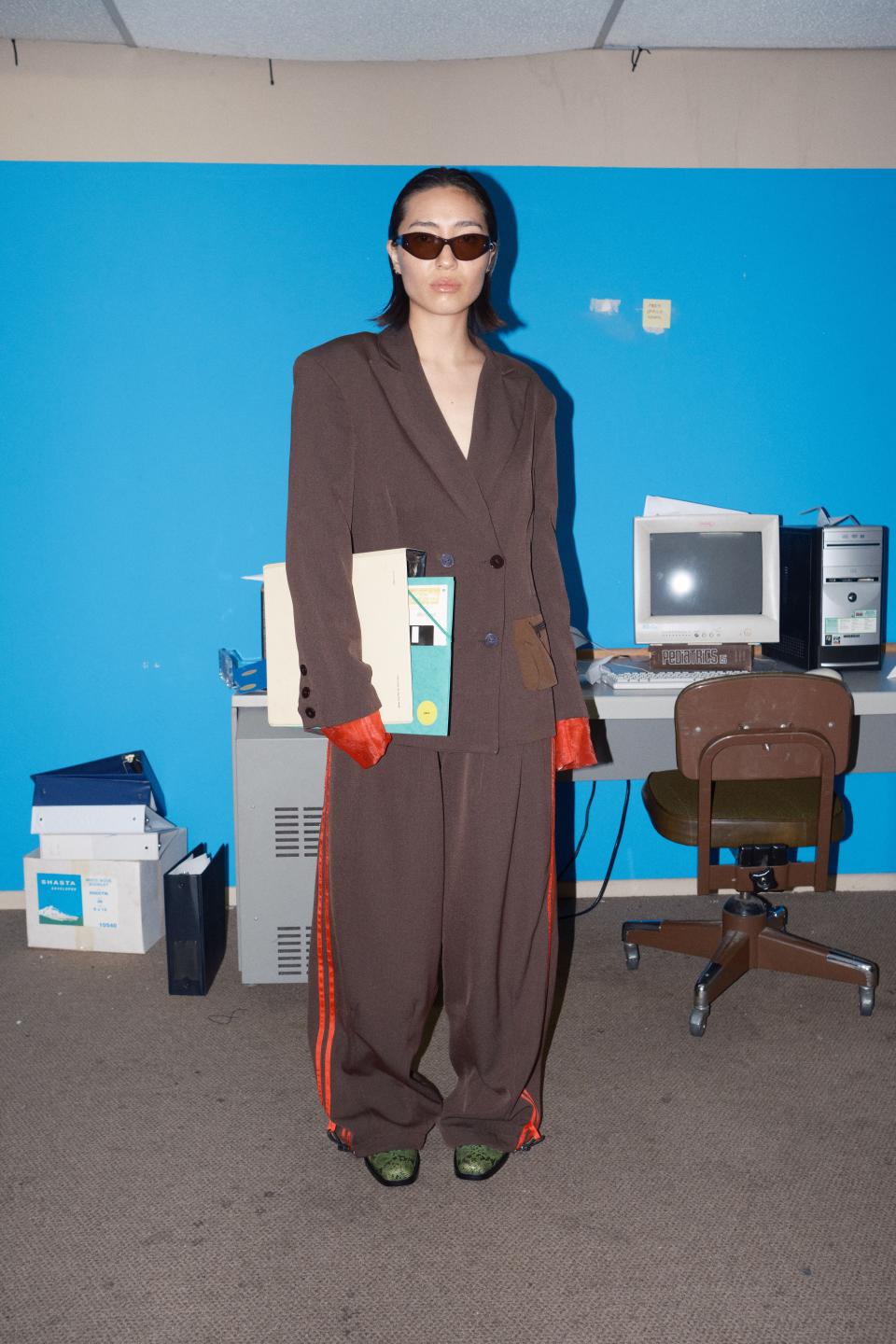
What fascinates me most about this trend is how the design references are being pulled directly from the catalog pages of outdated office aesthetics. The seed was firmly planted in 2021 when Vogue shot its September issue at the Condé Nast office at One World Trade Center in New York City. The following year, Bella Hadid would go on to star in a campaign for Balenciaga and Adidas that took place in a high-rise office. (The SS23 collection originally debuted on the stock exchange floor.) Toward the end of 2023, Kim Kardashian posed in an office for GQ’s Man of the Year cover. Fast-forward to January of this year to see fashion icon Marc Jacobs shooting FKA twigs, Dakota Fanning, and Lil Uzi Vert inside his SoHo office for the #MJ40 campaign.
Amy Auscherman, MillerKnoll’s director of archives, points out the larger significance of witnessing celebrities like Bella and Kim take up space in a corner office, given that it’s such an outdated concept. “It’s hierarchical, it’s patriarchal,” she explains. “The open office was supposed to signal a more egalitarian structure and matrix organizations. At the same time, women have always been in information professions. So the devaluing of administrative assistants, secretaries, librarians, or stenographers, where those are the people that actually need a workstation in a workplace versus an executive that’s like taking phone calls…there’s a bit of a disconnect when you have people leaning into a trend where they’re also not considering what type of work this theater equipment accounts for.”
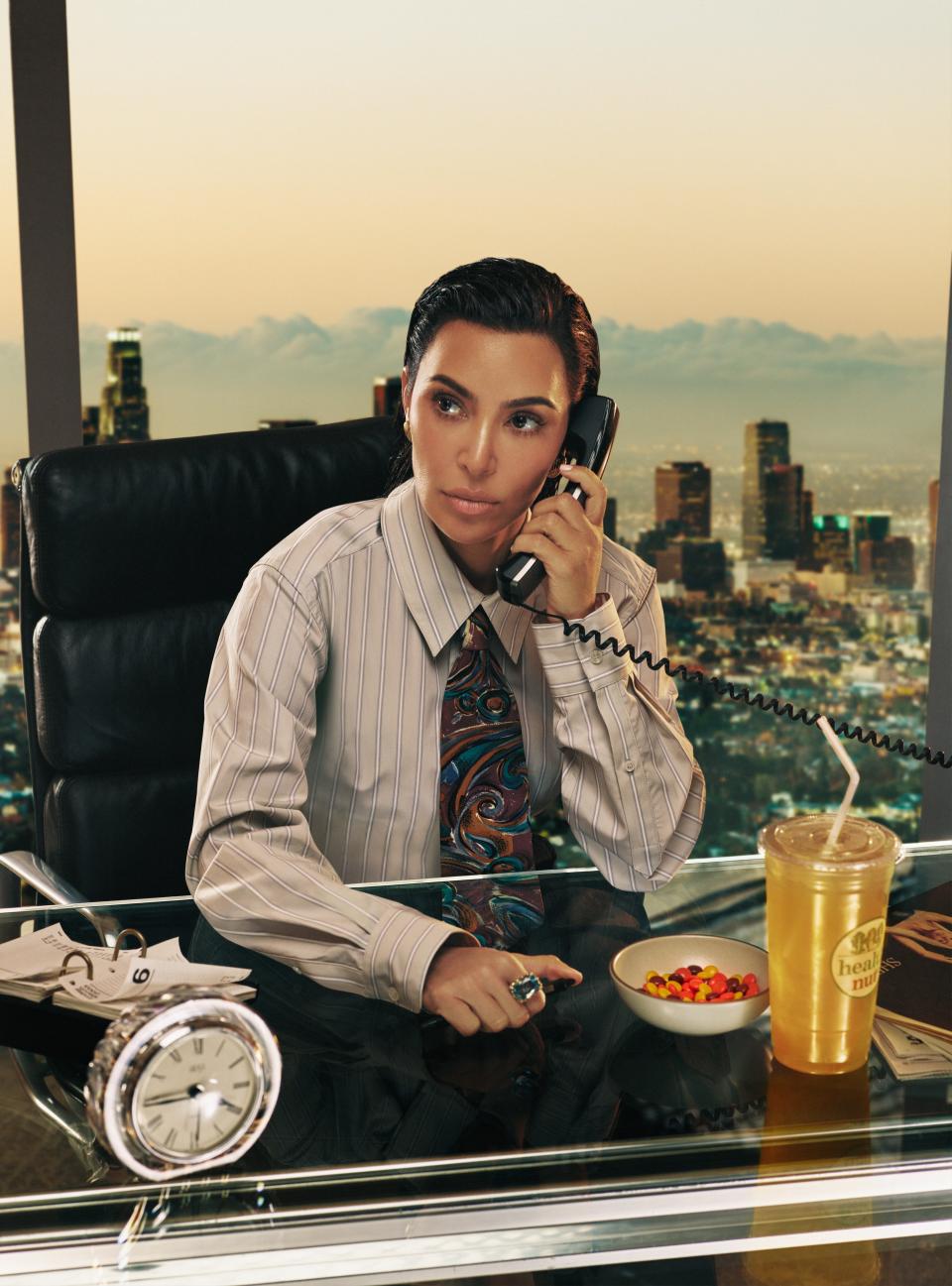
From that point of view, the corporate fetish aesthetic seems to flirt with this idea of progressive women reclaiming—and dominating—their place in the office. Society may have banished the girlboss, but she has risen from the ashes and she’s wearing a boxy, oversized power suit as armor. (After all, the best revenge is dressing well.) She’s left behind the neon pink-lit pedestal turned corporate chic cringe, but still desires to feel empowered from her seat at the communal table. With the three G’s (“gaslight, gatekeep, girlboss”) as her witness, she is an unstoppable force. At the peak of girlboss’s success as a media brand, founder Sophia Amoruso was most passionate about “exploring the intersection of work and life.” When building the HQ with Barbara Bestor in Silver Lake, she leaned into her love for vintage by curating the space with objects like De Sede’s Non Stop sofa and the Ultrafragola mirror by Ettore Sottsass, alongside modern essentials like Vitra desks and Amazon chairs.
During this era, AD100 designer Rafael de Cárdenas would set a trend in motion that we now recognize as “millennial aesthetics” with the Glossier office in SoHo. Since then, many celebrity-fronted brands like SKKN (concrete floors, plywood furniture, natural stone, and neutral tones) and Rare Beauty (warm tones, cozy textures, and soft lighting) have loosely followed the Brutalism-for-beginners formula with greige or pastel-pink-tinted minimalism and cavernous lounge spaces filled with modular furniture on slabs of concrete. While I can’t speak to Selena Gomez’s home, the SKKN office is an extension of the sculptural Calabasas estate where Kim and her three children reside.
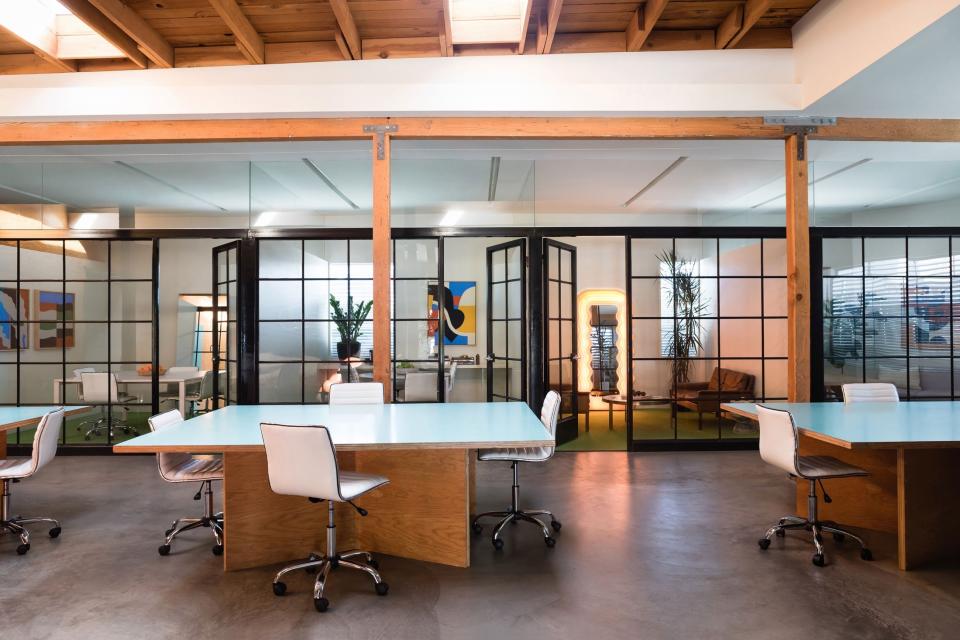
Unlike the traditional style of corporate settings, most modern workspaces in the post-pandemic era have adopted more of a homey vibe complete with functional kitchens for employees to gather. Fast Company recently declared that the office is “entering its lounge era” by retiring private offices, private meeting rooms, and conventional workstations (i.e. cubicles and desks) in favor of “informal” coworking spaces, with comfortable sofas and lounge chairs, that look like something between a living room and a hotel lobby. When Lauren Lynch, a Los Angeles–based architectural designer, was designing spaces for WeWork, most of her clients were interested in interiors that blended elements of residential and hospitality spaces with soft seating, white oak wood, plants, and high pile rugs.
“This was a design strategy that WeWork really launched into the mainstream, as it made sense to take inspiration from typologies that were the opposite of fixed desks and cubicles,” she says. “The goal was to turn the traditional workplace on its head. Perhaps spaces that evoked the comfort of our own homes and social spaces would drive productivity and innovation in unexpected ways—and for a while, I think this worked pretty well.”
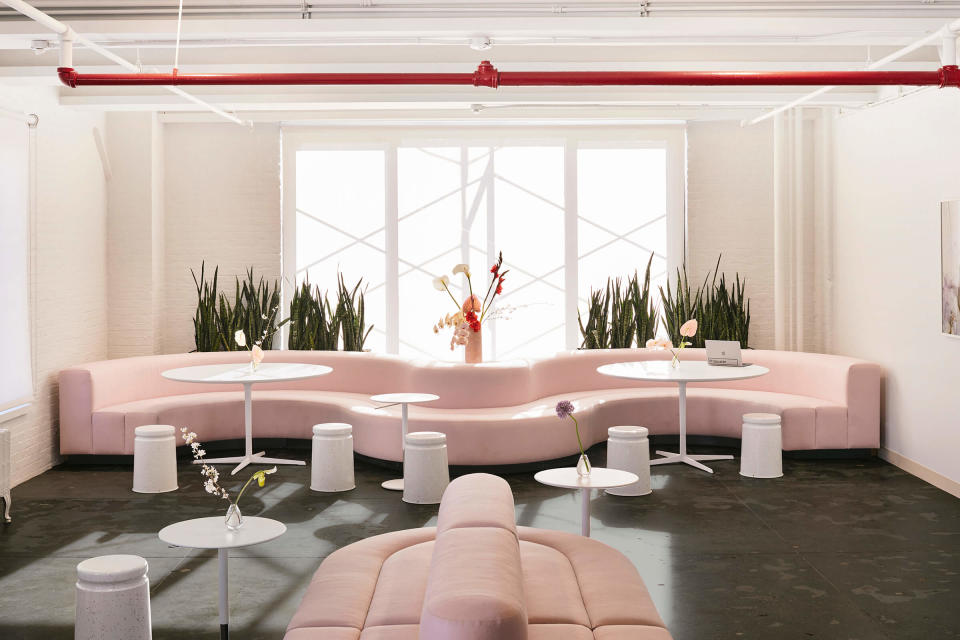
During Laetitia Gorra’s stint as head of interior design at The Wing, she was focused on designing inclusive spaces that centered the people that coexisted within it. “We learned so much as designers for that space [about] how people use physical spaces to build community,” she says. Now, as the founder and CEO of Roarke Design Studio, she caters to clients that want offices that prioritize the happiness and well-being of their employees. “I feel like employers are thinking through employee happiness much more than they were a decade ago,” Laetitia insists. “They’re thinking about it in terms of it being a retention tool and a hiring tool. If you are setting your employees up for success, that’s the ultimate goal. I think so much of success is your surroundings. How are you functioning in these spaces?”
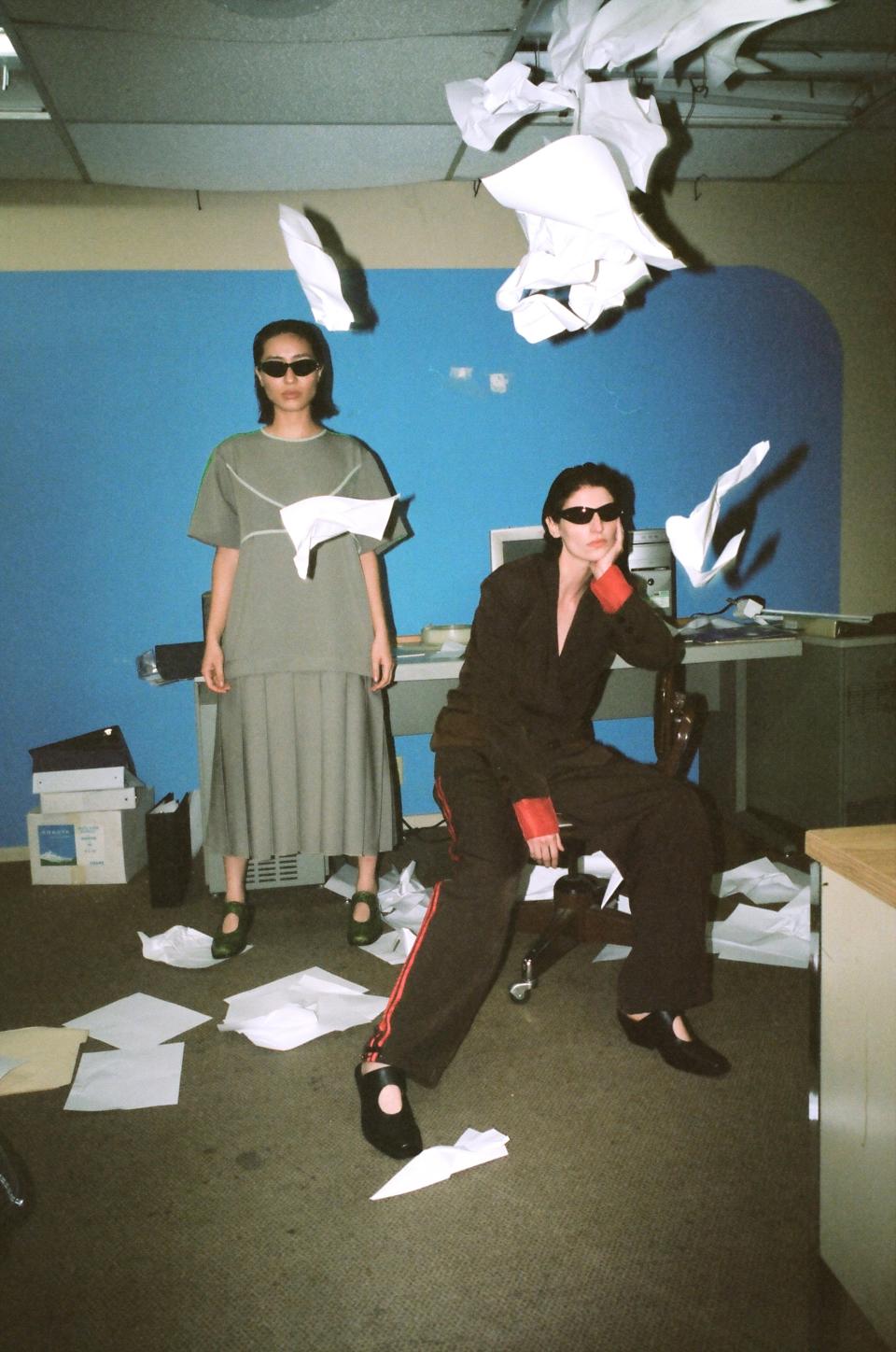
Kara views the corporate fetish aesthetic as an inherent subconscious concept that so many creatives are gravitating toward out of a sense of familiarity. “When you hear the word ‘office,’ I immediately go to fluorescent lights, low ceilings, carpet and a cubicle,” Kara says. “Aesthetically, it also adds to the secure aspect of it. I feel like if we were to shoot in a modern office, it wouldn’t give it that punch it needed.” Obviously, what we’re seeing in this imagery is the “fun” parts of being in the office. But as we, the working class, find ourselves returning to the office at full speed, the reality is that these settings don’t look or feel the same as before the pandemic. What seems to be missing from the equation of the “new normal” that is hybrid working in its current iteration is the structure, routine, and friendships that are attached with the outdated office environment. Instead, what we now have is a void that stems from a need for third places.
According to Laetitia, the main task of the designer is to figure out how to incorporate a company’s culture into how they build out these spaces so employees will actually want to come into the office. Given the growing number of people that are less motivated to return to the office, it’s ironic that the office has still managed to become a modern-day muse. Last year, Globest reported that vacancy rates for offices in Manhattan would rise to 20% through 2026. Rather than working remotely from home, businesses like Houseplant and Ghia are opting to work in homes by converting houses into headquarters suitable for their employees to maintain productivity.
On the other end of the spectrum we still see tech empires going for the college campus style, or as professionals prefer to call it, the corporate campus. As Docomomo states, corporate campus architecture emerged during the postwar boom; as the middle class moved to the suburbs, legacy companies seized the opportunity for “expansive campuses, large parking lots, tax breaks from local governments, and a chance to rebrand themselves.” On this note, Amy asks an important question: “What are the amenities of a [corporate] campus beyond what you need to get your work done?”
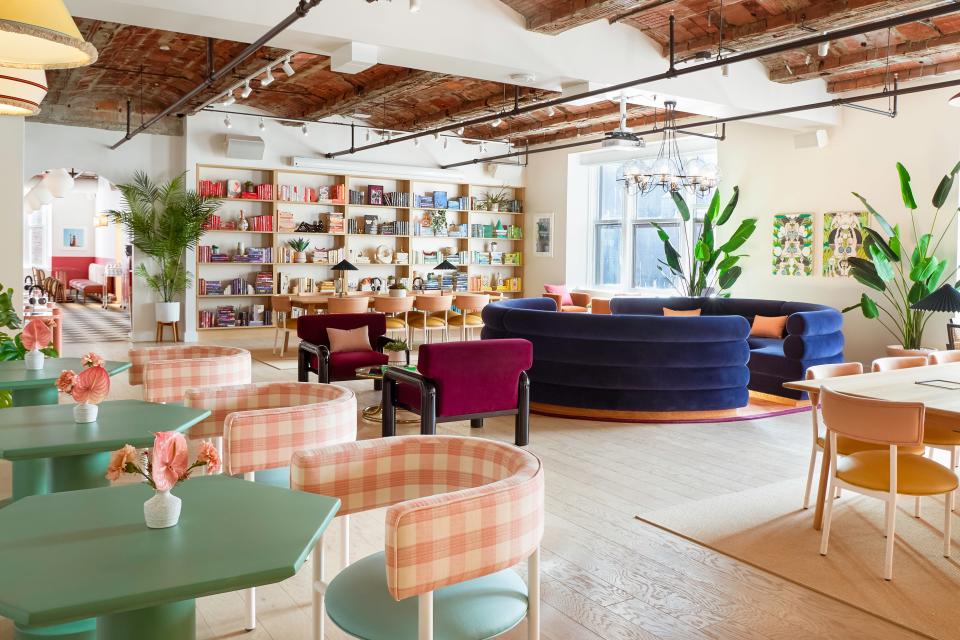
Lauren attributes this vibe shift to symbols changing. “Today’s young workers grew up in an era where Facebook and Google were already household names and tech campuses were nothing new,” she explains in an email. “By the time they entered the workforce, the novelty of start-up culture had mostly worn off. To this generation, Ping-Pong tables, nap pods, and other such amenities are at best gimmicky and at worst manipulative tactics for decimating employee work-life balance. It makes sense that more buttoned-up, corporate office tropes suddenly feel alluring. It’s only human nature to desire newness, hence why the starkness of traditional office interiors feel like a brutally honest and refreshing escape.”
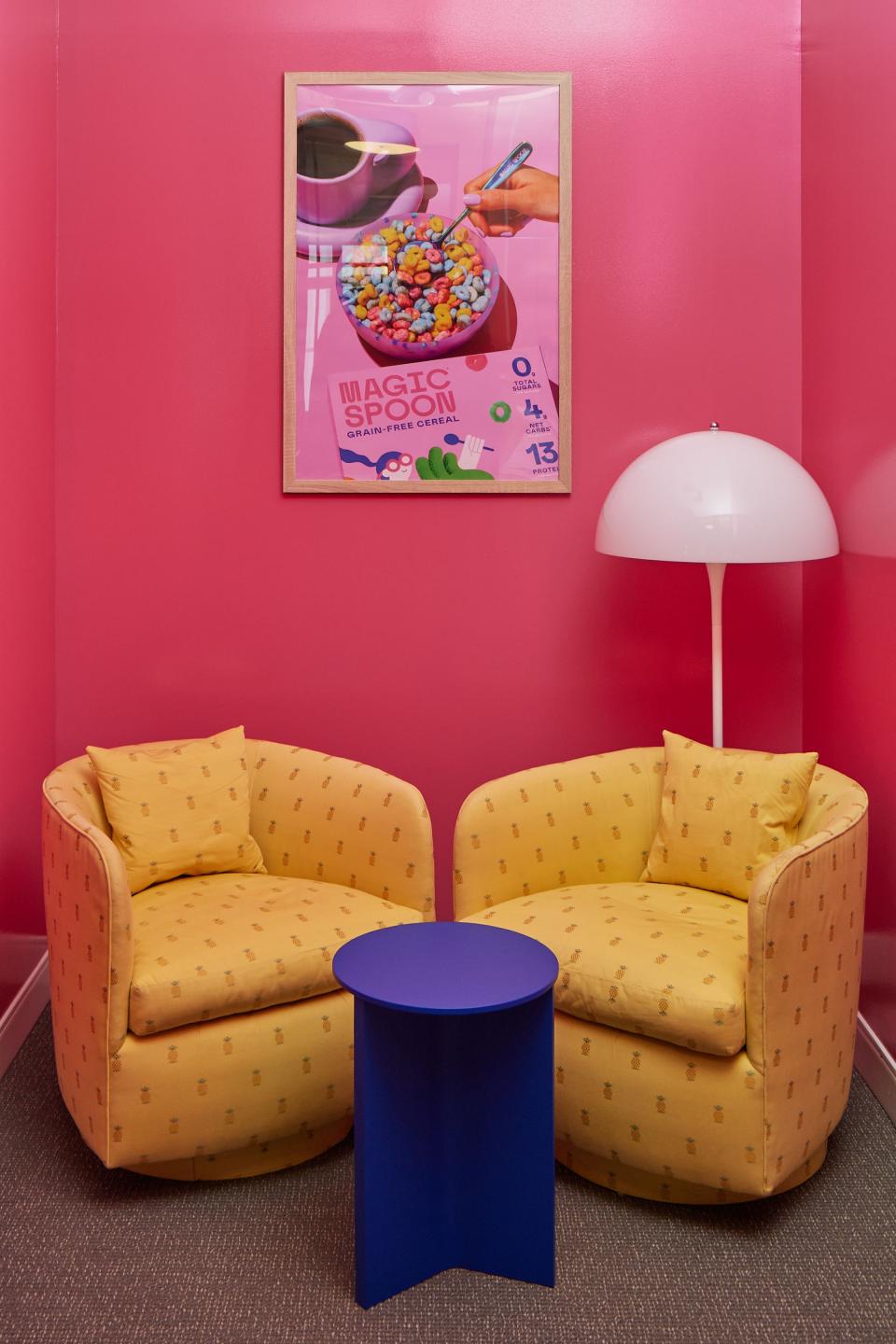
Laetitia also points out how elements of wellness are more commonly incorporated in today’s corporate culture like meditation rooms for people who might “need to take a repose in the middle of the day.” She thinks companies that aren’t prioritizing this are doing themselves a great disservice, arguing that feeling inspired by your surroundings not only enhances productivity, but it makes everyone happy. “You’re going to work harder, there’s going to be a higher ROI in terms of employers,” she adds. “Happiness means more money, everybody wins.”
But millennials like Lauren are disinterested in elevated corporate workspaces that feel like a nicer version of a living room, preferring high modernist interiors from the portfolio of architecture pioneers like Mies Van Der Rohe. She insists that Kevin Roche did it best with iconic buildings like Ford Foundation in New York and Union Carbide Headquarters in Danbury, Connecticut; his spaces “embody the sleek minimalism of modernism while using flashy, playful finishes to create something visually stimulating and almost surreal—exactly the type of environment that would galvanize me for my morning commute.”
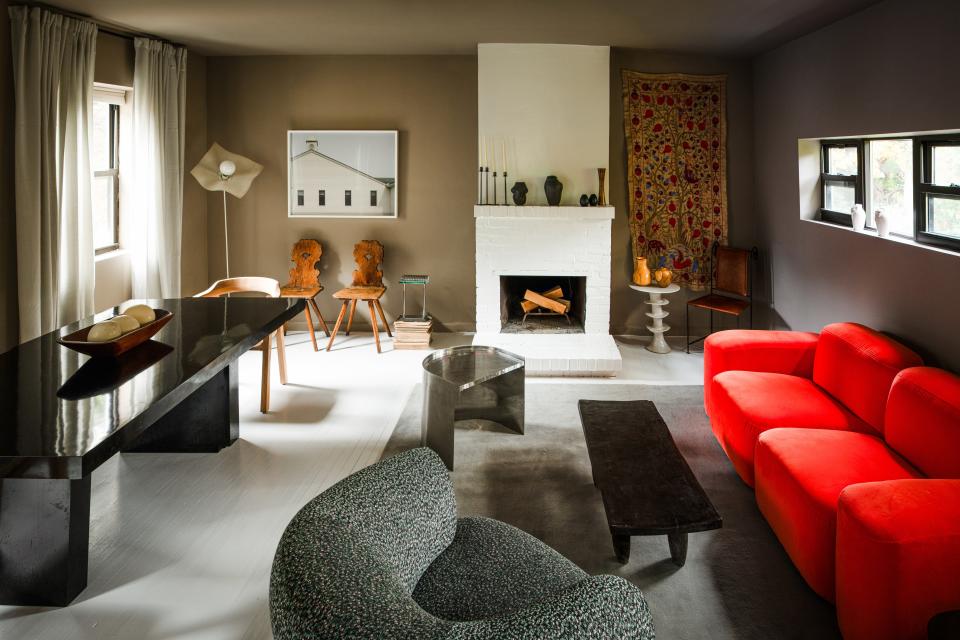
For the next phase of evolution in office design, Laetitia is thinking deeply about how to pull in more residential touches. She refers to this new era as “envy offices” that aren’t just Instagrammable, but offer a balance between functionality and inspiration. Most importantly, you don’t want people to feel trapped there—the office should be a welcoming space equipped with all the necessary tools for people to do their best work. “It comes in design, but it also comes in ambience,” she explains. “It comes in the music. It comes in the temperature. It comes in the ergonomics of the sofas. It comes in just incorporating those company-culture elements into the experience when you’re in the office. We don’t need to make people feel like they need to be in the office 24/7.”
At her own micro-coworking space in Hastings-on-Hudson, where the actress Molly Ringwald is reportedly a founding member, Laetitia saw an opportunity for people like her with hybrid work models that live in the suburbs but want to get out of the house without the hassle of going into the city. “Maybe it’s because I’m a designer, but I’m such a believer that your surroundings really help you—especially as a creative—create content and produce work so much better than being in a gray, ugly, uninspiring, just super functional workspace.”
Kara refers to her office as a studio because it feels more like an open space for boundless creativity. (Her dream office location would be in a building in Frogtown with good natural light that overlooks the river.) As a longtime resident of Los Angeles, the fashion designer is used to breaking up her work day with outdoor activities like going on a hike. “Working from home doesn’t mean you’re at your computer from 9 to 5… I have so many friends that work from a campsite sometimes,” she says. This is what partially inspired the idea of bringing technical materials and fabrics back into an office environment, like a suited blazer made out of Japanese recycled materials with nylon technical pockets. “It’s on both spectrums where we have an actual suit or we have something that’s super technical,” Kara adds.
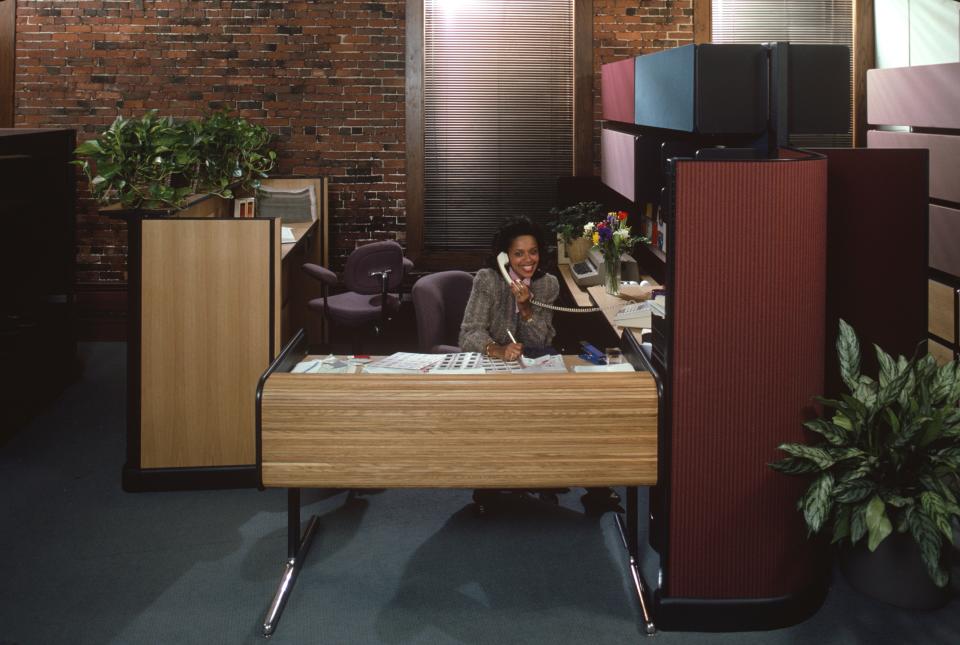
Office With Herman Miller Furniture
Let the record show that Amy predicted the “officecore” trend in 2021 after being taken aback by a post from fashion designer Martine Rose that depicted duplicates of the model Nassia Matsa in a glitchy office simulation. “I don’t tweet, but it was like, ‘I’m calling this,’” Amy remembers. “That is Herman Miller promotional photography—you see the Wilkes modular seating in it, but obviously I clocked it because that’s Action Office.” Ultimately, this was a palette cleanser for a new era that was loading; the office served as the London-based designer’s muse for the entire fall-winter 2022 collection. (At the time, Martine told Vogue that it represented the surreal dream state we were stuck in from “blurring of boundaries between working from home and in the office” while living in lockdown.)
Laetitia notes that prior to the pandemic more people were into the idea of an open office and being together in a communal space. But now that we’re on the other side of an extended period of isolation, she finds that people want personal space again. “They’re looking for nooks to be incorporated into design,” she explains. “From a company-culture perspective, there are more boundaries now in terms of how much you can really ask of somebody to be in the office at all times.” Upon closer examination, it’s interesting how so much of the corporate fetish imagery we’re being served on a silver platter depicts an era that valued physical boundaries and privacy.
“It’s a time when you had delineated space in a more real way and there’s a formalness to it, or you dress up,” Amy says. “People’s relationship with what they use the office for has changed and maybe that opens up the amount of space you’re able to take up while you’re there.” In pointing out that the office is in itself a boundary because “it’s separate from your house and it’s a place to go,” Amy also wonders, “How does an office play as a backdrop to the minutiae of interpersonal relationships and who gets to have privacy?”
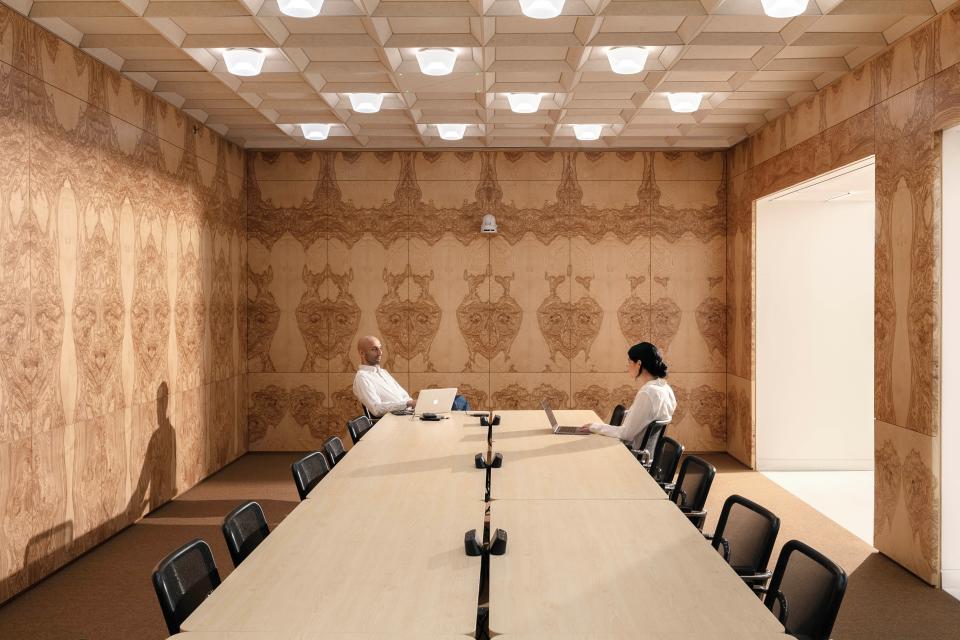
As these unadulterated thrills subside, Amy is curious to see where the corporate fetish aesthetic goes from here, especially considering the amount of young people that have seemingly missed out on the experience of working in an office. What was once an abandoned vacancy is now viewed as an escape. “Being in the office-furniture business, there’s still this big question mark as to whether or not people want to be in an office,” she says. Whether or not people are willing to admit it, the office does provide a sense of community; it’s a place to be and a place to perform labor. This is why Amy jokes that the office is also a theater. “It’s a stage set. It’s a runway. It’s a place to be perceived,” she explains. “And even if it’s not a place where you’re being most ‘productive,’ it’s still a space in which people have interest in being in and obviously is quite literally being fetishized.”
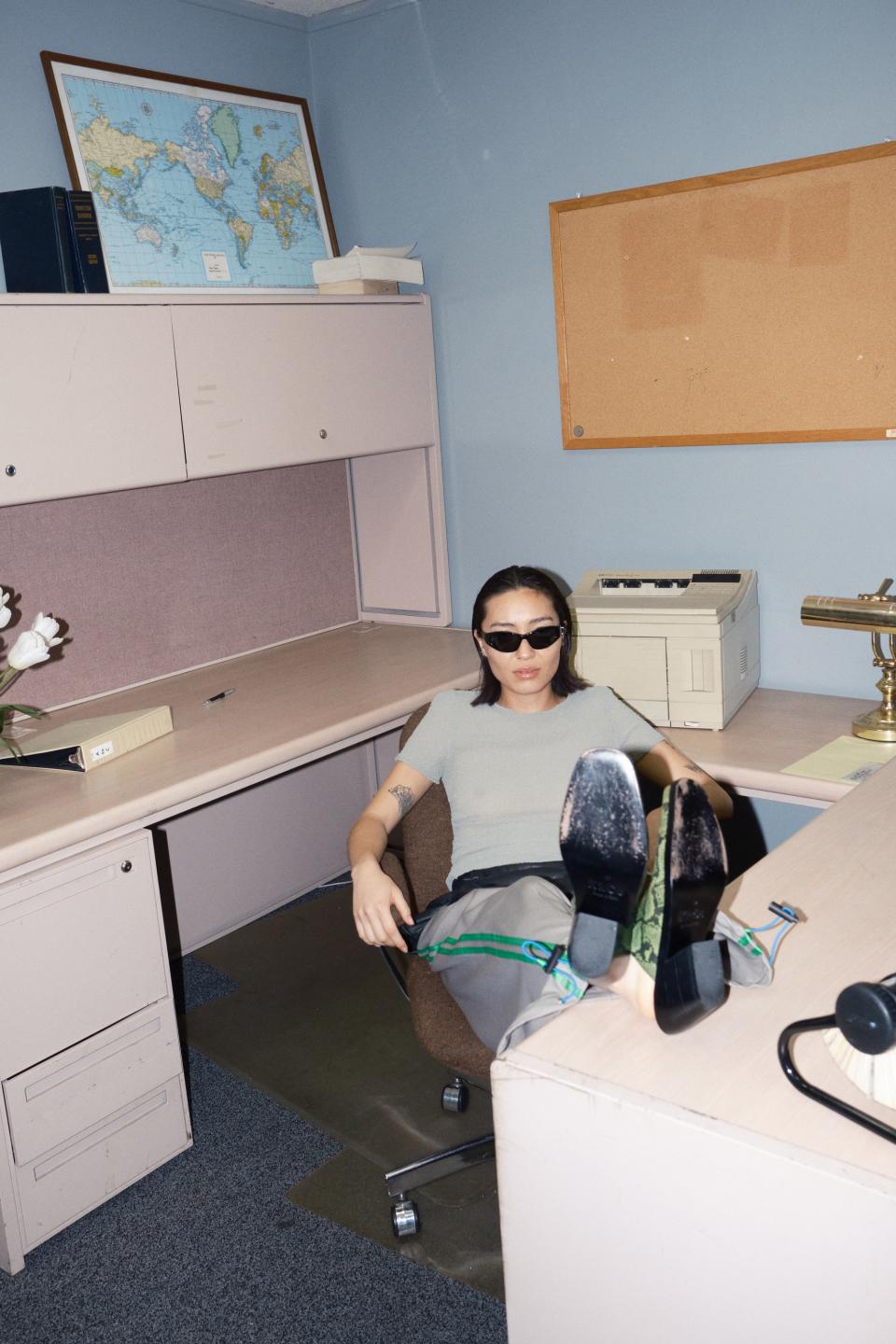
Lauren has noticed more clients asking for spaces that feel harmonious with corporate-fetish aesthetics. “Last year, I designed the New York headquarters for a major data technology company who requested a space that embodied the spatial planning principles of a coworking space (flexible work environments, wellness rooms, etc.) while also evoking a grown-up office interior that would drive the visual language of their future spaces. To accomplish this I was inspired by the sleek metals and loud wood veneers of high modernist interiors of midtown Manhattan.”
From a business perspective, Amy thinks it’s important to consider one’s role of playing into a trend like this and really extrapolating what people actually want out of an office. Harvard Business Review reports that companies will have to consider exploring “more impactful and creative benefits” in order to attract and retain talent if they want employees to feel less financially burdened to come into the office in 2024 and beyond: “What was once largely assumed—that employees bear certain costs of work when they agree to take a job—can no longer be taken for granted, particularly given that there isn’t a definitive relationship between location of work and performance.”
With the viral photograph of Sofia Coppola’s home office burned into our collective memory, I can’t help but wonder if we’re all just pawns feeding into the larger corporate machine under the pressure of inflation. As if the constant whispers of an impending recession and the threat of AI technology replacing creatives isn’t concerning enough, it’s bizarre to see the “corporate fetish” trend explode during a transitional time where millennials and Gen Z are actively quiet quitting and choosing “lazy girl jobs” that pay less but offer more flexibility in order to have a life outside of work. In the face of obstruction of traditional career paths, why do we yearn for the ghosts of the office past?
“As an architect, I’m always interested in taking an idea that’s seemingly banal and recontextualizing it,” Lauren says. “In the case of the corporate fetish trend, it’s all about subverting traditional power dynamics and taking the power back from oppressive work environments. By adopting the austerity of traditional office interiors, the trend simultaneously serves as a critique of our workplaces while also asserting a playful agency over a system most of us cannot escape.”
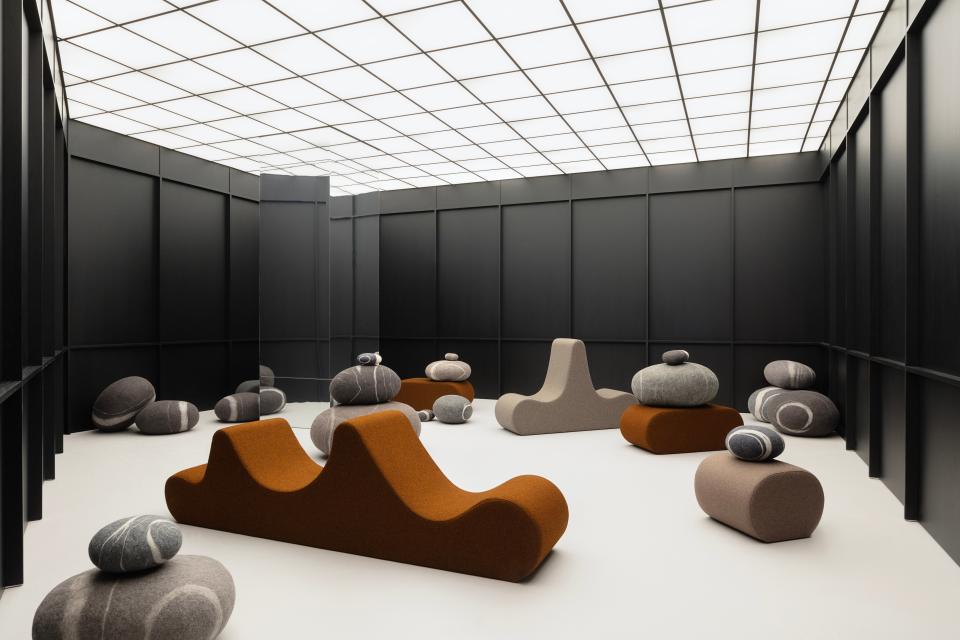
WSA, located in the former headquarters for AIG in the Financial District, seems to be leading the corporate fetish renaissance as a backdrop for the aesthetic—The Elder Statesman recently shot an “interdimensional surf” themed campaign at the modern workspace, which is spread across 31 floors. For Gabriella Khalil, who is spearheading the creative, design, and event programming at WSA, the mission is to break barriers by cultivating elevated experiences within the modern workspace while also building community in a non-traditional way. “I always overuse the word community, but I feel like people want to feel like they’re part of a community, and that goes along with work too,” she says. “That’s where we are all day, or that’s what we’re all doing. To me, the future [of the office] is having spaces that feel visually inspired, that feel elevated, and that feel like they can bring like-minded people together to network and help each other.”
Gabriella was heavily inspired by offices in the late ’80s (especially as portrayed in film) when conceptualizing the visual narrative of the office tower. Every floor within the 700,000-square-foot building has a different aesthetic, but some common themes that can be spotted throughout the space are burl wood tables, travertine floors, and carpeted walls. Some coworking areas have vintage Italian furniture and Ettorre Sottsass bookcases, while other offices come with carpeted phone booth dens and USM cubicles. For the 10th floor, Gabriella chose aluminum blinds for the windows that play with the lines and shadows without obstructing the beautiful view of the waterfront. The glass conference rooms on the 15th floor feature flowy curtains that allow for more privacy during meetings. If you can’t afford to waste time taking a lunch break, there’s a café in the corner of the lobby—or “break room” areas stocked with nutritious snacks and cans of Ghia in the fridge. Needless to say, it’s a vibe.
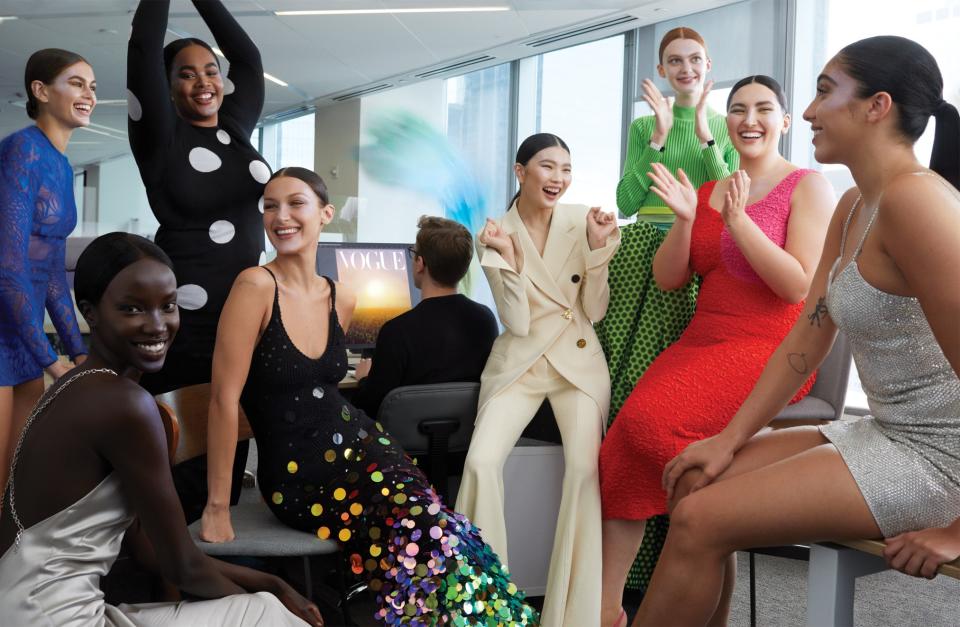
Beyond the striking design elements, WSA also includes a variety of luxurious amenities, as seen on the 12th floor, a cream-toned haven where beauty and wellness services await: nail art, facials, and lymphatic drainage massages. (Some of the other floors function as art studios and gallery spaces.) While the project is still underway, Gabriella is most excited about unlocking the full potential of the space and continuing to build out the big picture of what she describes as a visual journey. “There’s a real want for these experiences across the board,” she says. “And I think the workplace is also part of that. People want, not a different experience, but a unique, inspired experience even for work… People want to be around other people.”
Naturally, some of us are workaholics that won’t be able to resist taking our corporate fetish home; the aluminum blinds on the glass wall inside this Charlap Hyman & Herrero–designed apartment in SoHo are a prime example. (The idea came directly from a reference photo of a Japanese office, which Adam Charlap Hyman previously described as having a “’90s-corporate-cubicle vibe that I found really aesthetically pleasing.”) “Ultimately, COVID liberated us from the idea that the office should manifest in one specific way,” Lauren explains. “Whether this means offices inspired by coworking spaces or the resurgence of the corporate cubicle, it’s important to keep in mind that design should always be more than just copying and pasting various trends. Precedent research and the use of references is vital to the creative process of many great designers, but it has to be done correctly. There’s a fine line between design that is cleverly referential and design that feels imitative. Interior designers and architects are trained to walk this line carefully and can help clients utilize the trends they’re interested in while ensuring that individuality remains at the center of the work.”
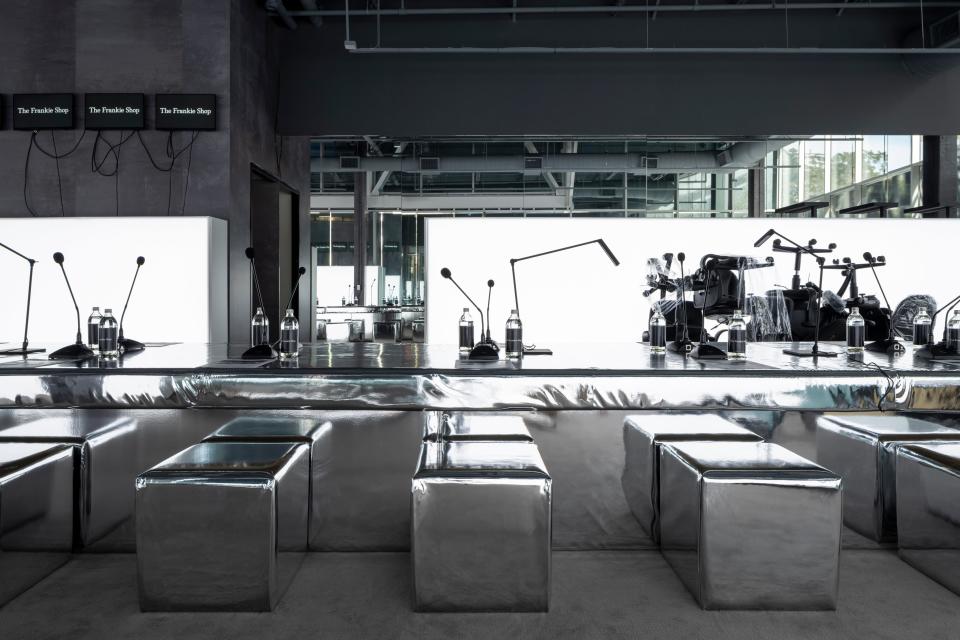
Josh Cho Photography - Los Angeles Architectural Photographer
While Patrick Bateman’s office in American Psycho captures the “cocaine decor” aesthetic of Wall Street offices that once reeked of toxic masculinity in the early ’90s, the real undertone that Amy picks up on is “horny office” with a view. This fantasy looks like a combination of private offices, cubicles, and workstations with panel-based systems. “It’s a callback to a time that does not exist right now, therefore it is idealized,” Amy adds. “The future of the office is actually what we’ve been doing in the past, maybe that’s good, though, in some ways.”
Crosby Studios recently created an office-themed installation in Los Angeles for The Frankie Shop in a building reminiscent of an abandoned warehouse on Sunset Boulevard. Even though the space is filled with recycled office equipment, Crosby Studios founder Harry Neuriv insists that “The Meeting Room” is a commentary on life outside of the office and the uncertainty around what happens next. “It’s a symbolized idea that we need to move on to something else,” he writes in an email. Given that his first project dedicated to office culture—an installation at Design Miami in 2018—was an ode to the place where his creativity began to take shape as an intern, it’s fitting that this new installation arrives at a time where “we are celebrating the end of an era of the office.”
In an overview of the office for The Cut, Emilia Petrarca wrote that “the office is where beauty, creativity, and humor go to die.” On the contrary, Amy argues that “young people are horny for the office” and the response to that demand ultimately bodes well for the stability of companies that contribute to the manufacturing of it. Lauren fully agrees and insists that the classic corporate skyscraper will always persevere because it maintains the appeal of permanence and prestige. “I think people do actually like the idea of working in an office space that holds some weight; it’s important to make the internal adjustments to ensure this type of space is relevant and desirable to future generations,” she concludes. “After all, architecture can only do so much—it’s still on our employers to create healthy work environments through building better corporate cultures.”
Originally Appeared on Architectural Digest

